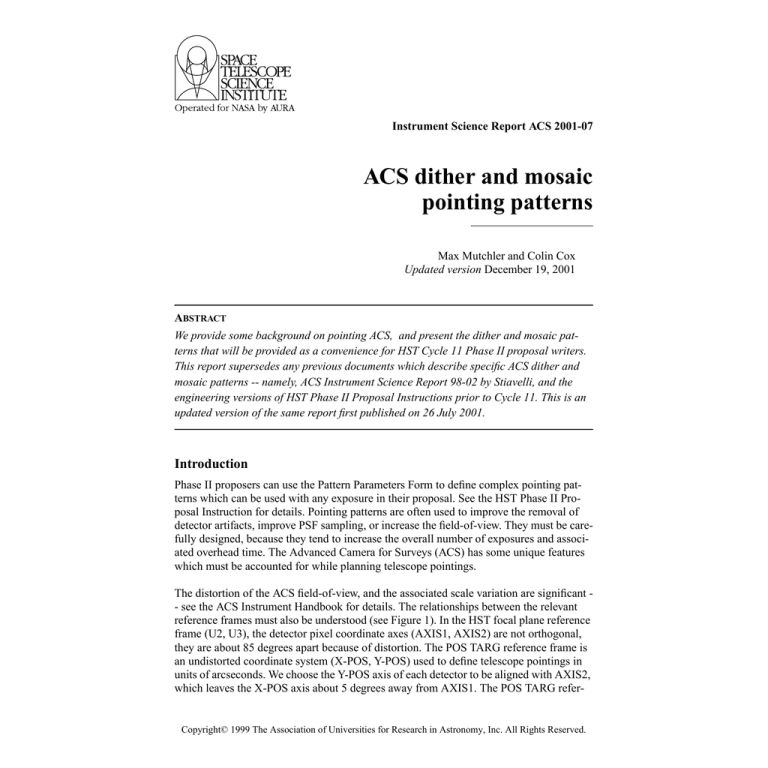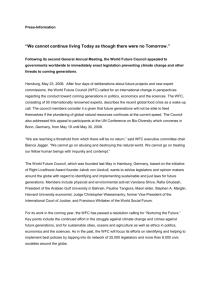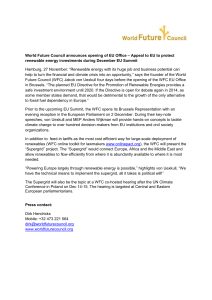
Instrument Science Report ACS 2001-07
ACS dither and mosaic
pointing patterns
Max Mutchler and Colin Cox
Updated version December 19, 2001
ABSTRACT
We provide some background on pointing ACS, and present the dither and mosaic patterns that will be provided as a convenience for HST Cycle 11 Phase II proposal writers.
This report supersedes any previous documents which describe specific ACS dither and
mosaic patterns -- namely, ACS Instrument Science Report 98-02 by Stiavelli, and the
engineering versions of HST Phase II Proposal Instructions prior to Cycle 11. This is an
updated version of the same report first published on 26 July 2001.
Introduction
Phase II proposers can use the Pattern Parameters Form to define complex pointing patterns which can be used with any exposure in their proposal. See the HST Phase II Proposal Instruction for details. Pointing patterns are often used to improve the removal of
detector artifacts, improve PSF sampling, or increase the field-of-view. They must be carefully designed, because they tend to increase the overall number of exposures and associated overhead time. The Advanced Camera for Surveys (ACS) has some unique features
which must be accounted for while planning telescope pointings.
The distortion of the ACS field-of-view, and the associated scale variation are significant - see the ACS Instrument Handbook for details. The relationships between the relevant
reference frames must also be understood (see Figure 1). In the HST focal plane reference
frame (U2, U3), the detector pixel coordinate axes (AXIS1, AXIS2) are not orthogonal,
they are about 85 degrees apart because of distortion. The POS TARG reference frame is
an undistorted coordinate system (X-POS, Y-POS) used to define telescope pointings in
units of arcseconds. We choose the Y-POS axis of each detector to be aligned with AXIS2,
which leaves the X-POS axis about 5 degrees away from AXIS1. The POS TARG refer-
Copyright© 1999 The Association of Universities for Research in Astronomy, Inc. All Rights Reserved.
Instrument Science Report ACS 2001-07
ence frame for each detector is related to the HST focal plane (U2, U3) by a simple translation and rotation. For the WFC, the Y-POS axis is approximately in the U3 direction and
X-POS falls near -U2. However, for the HRC and SBC, the Y-POS axis is near the -U3
direction and X-POS falls close to the U2 direction.
Figure 1: The relative orientations of the detector pixel axes (AXIS1, AXIS2), telescope
pointing axes (X-POS, Y-POS), and the HST focal plane axes (U2, U3). This graphic does
not reflect the relative positions of the WFC, HRC, and SBC apertures in the HST focal
plane.
The patterns described in this report have been designed in terms of pixel coordinates.
However, in Phase II proposals the shifts must be defined in arcseconds, and angles measured from the X-POS axis. For example, a displacement of one WFC pixel in the detector
x direction is 0.0496 arcsec along X-POS plus 0.0038 arcsec in the Y-POS direction, and a
displacement of one pixel in the y direction is 0.0497 arcsec along Y-POS. The angle of
this 1x1 pixel shift turns out to be 47.17 degrees, not 45 degrees (see diagram below).
Using the distortion coefficients in Table 1, and the equations below, the POS TARG and
Pattern Parameter Form values can be calculated for any (x,y) pixel shift. These distortion
coefficients were derived from pre-flight ground calibrations, and were used to determine
the pattern parameters below. They may be refined after on-orbit distortion calibrations are
conducted, but we don’t expect the values to change by more than a few percent. The a10
coefficient will always be zero, because we defined the Y-POS axis to be the same as the
detector y axis (AXIS2).
2
Instrument Science Report ACS 2001-07
Table 1. Coefficients for converting detector pixel shifts into POS TARGs in arcseconds.
Detector
a10
a11
b10
b11
WFC
0.0000
0.0496
0.0497
0.0038
HRC
0.0000
0.0283
0.0248
0.0028
SBC
0.0000
0.0337
0.0296
0.0034
XPOS = x ⋅ a 11 + y ⋅ a 10
YPOS = x ⋅ b 11 + y ⋅ b 10
PointSpacing =
2
XPOS + YPOS
2
PatternOrient = atan ( ( YPOS ) ⁄ ( XPOS ) )
For box patterns, the Line_Spacing is calculated like the Point_Spacing, except using the
(x,y) shift from the 2nd to the 3rd pointing. The Angle_Between_Sides is 180 degrees
minus the Pattern_Orient of the second segment, minus the Pattern_Orient of the first segment. See the HST Phase II Proposal Instructions for more on pattern parameter definitions.
3
Instrument Science Report ACS 2001-07
Convenience patterns
Proposers are always free to design their own pointing patterns, but since subtleties like
those mentioned above are potential pitfalls, carefully optimized dither and mosaic patterns have been defined in the Phase II Proposal Instructions for each instrument. We
strongly encourage the use of the Visual Target Tuner (VTT) to plan and verify pointing
patterns (see Figures 3 and 4). In the following sections, we describe the “convenience”
patterns designed for ACS users. We define them in the syntax required for HST Phase II
proposals, and provide diagrams of each. The Pattern_Number can be any unique integer the numbers we use here are merely to identify each pattern within this report. The
Pattern_Purpose is just a descriptive comment that distinguishes small-scale dithers from
large-scale mosaics. And although we include them below, the Line_Spacing and
Angle_Between_Sides (for box patterns only) are not included in the Phase II proposal
syntax because they are unchangeable. We also provide POS TARG equivalents for each
pattern, but using these will not automatically produce an associated dataset.
In the original version of this report (26 July 2001), the POS TARG equivalents given for
the mosaic patterns were correct for Center_Pattern=NO (where the target is placed at
the specified aperture of the first pointing). In this version, they have been made truly
equivalent, reflecting Center_Pattern=YES (where the target is placed at the center of the
overall mosaic pattern). The POS TARG equivalents for the dither patterns (where
Center_Pattern=NO) are unchanged from the original version of this report.
Pointing patterns with dimensions less than 130 arcseconds are automatically associated
by the ground system software (i.e. TRANS), because they could be executed with one set
of guide stars. In practice, the rule-of-thumb implementation limit is closer to 100 arcseconds -- all dependent on guide star availability in the target field. All of the ACS pattern
dimensions described in this report are under 100 arcseconds, except the 4-point WFC
mosaics (Pattern_Numbers 17 and 18). For now at least, these patterns would require the
use of POS TARGs and multiple sets of guide stars. And although the 2-point WFC
mosaic (Pattern_Number 15) shift is under 100 arcseconds, it too could require the use of
two sets of guide stars, depending on the target field. Future enhancements to the ground
system software may allow for mosaic patterns with any dimensions (involving any number of guide stars) to be associated. However, post-observation association tables can be
manually constructed and used to reduce mosaicked WFC datasets, if necessary. Phase II
proposers who design pointing patterns with any dimension approaching 130 arcseconds
are advised to work closely with their Program Coordinator, to ensure that their pattern is
implemented as efficiently as possible.
Each Pattern_Type has default values which reflect their most basic or common usage. If
the default values are desired, then the Pattern_Type can be used like any other exposurelevel special requirement in a Phase II proposal, and it is not necessary to provide a Pattern
Parameters Form. However, we also provide variations on the line Pattern_Types (box patterns cannot be modified as freely), involving more pointings or different goals. These
alternate patterns are merely examples or suggestions, which would require explicit definition in a Pattern Parameters Form (or the use of the corresponding POS TARG equiva-
4
Instrument Science Report ACS 2001-07
lents). A Secondary_Pattern form can also be defined, to achieve multiple goals in
conjunction with a Primary_Pattern form.
Although the Number_Of_Points is extensible up to 9, each pattern below was tailored to
the number of pointings. Furthermore, it may not be feasible to obtain more than six ACS
exposures in one orbit. Patterns can be executed over multiple orbits, but guide star reacquisitions will introduce additional pointing innaccuracies. We set Center_Pattern=YES
for the mosaic patterns only, so the defined target will be centered in the expanded fieldof-view.
It is not absolutely necessary to obtain multiple exposures at each pointing (CR-SPLIT) to
remove cosmic rays. The dither package in IRAF (which includes the drizzle task) provides for the removal of cosmic rays from single-exposure dithered observations
(Fruchter, 1997). This can significantly reduce the overhead time in a pointing pattern.
Simulated ACS images which incorporate these pointing patterns are available via the
webpage below. These are useful for testing data reduction and processing, including
image combination (e.g. drizzling). A sample of these simulations and the corresponding
reductions will be also be available as a pre-flight ACS example in the next version of The
Dither Handbook (Koekemoer, 2000).
http://hst.stsci.edu/acs/analysis/drizzle/
Pattern descriptions
Pattern_Numbers 11, 21, 31 are the default 2-point DITHER-LINE patterns for the
WFC, HRC, and SBC, respectively. They are designed to remove detector artifacts such as
bad rows or columns, hot pixels, and uncorrected flat field features. The WFC pattern is a
5x60 pixel shift which spans the interchip gap, which is about 2.5 arcseconds or ~50 pixels
across. At least two exposures should be taken at one of the WFC pointings (CR-SPLIT),
so that cosmic rays can be removed from the gap overlap region. Although this is defined
as an integer pixel shift, the effect of the scale variation becomes significant (especially
near the chip edges) over such a large shift. The HRC pattern is a smaller 5x5 pixel shift,
since there is no gap. The SBC has about 5 bad rows near the center of the detector caused
by a bad anode, so the default pattern is a slightly larger 10x10 pixel shift.
The following patterns are non-default examples of how these DITHER-LINE parameters
could be modified for various purposes. Pattern_Numbers 12, 22, 32 are very small 2point sub-pixel dithers (2.5 x 1.5 pixels) designed to improve resolution (1/2 pixel PSF
sampling) for the WFC, HRC, and SBC, respectively. Pattern_Numbers 13, 23, 33 are
small sub-pixel dithers which are similarly optimized for 3 pointings (1/3 pixel PSF sampling). Pattern_Number 14 is a 5x5 pixel shift for the WFC -- better for removing WFC
artifacts when the interchip gap is not a concern (i.e. for objects that fit on one WFC chip).
5
Instrument Science Report ACS 2001-07
Pattern_Numbers 15, 25, 35 are the default 2-point MOSAIC-LINE patterns designed to
increase the field of view for the WFC, HRC, and SBC, respectively. For the HRC and
SBC, this is a shift of ~95% of the y dimension of the detector (973 pixels) as projected on
the sky, which nearly doubles the field-of-view. For the WFC, the shift is only about 47%
of the y dimension of the combined WFC detectors (1948 pixels) as projected on the sky,
resulting in a roughly 200x300 arcsecond field-of-view. This is a compromise which
allows the 2-point WFC mosaic to be performed with one set of guide stars (and produce
an associated dataset), and it simultaneously covers the interchip gap.
Pattern_Numbers 16, 26, 36 are the default 4-point DITHER-BOX patterns for the WFC,
HRC, and SBC, respectively. They all have relative pixel coordinates (0, 0), (5.0, 1.5),
(2.5, 4.5), (-2.5, 3.0) -- a parallelogram pattern with a combination of integer and sub-pixel
shifts. This box pattern is relatively compressed in the y dimension compared to it’s
WFPC2 and STIS counterparts. This helps minimize the effect of scale variation across
the detector.
Pattern_Numbers 17, 27, 37 are large 4-point MOSAIC-BOX patterns for the WFC,
HRC, and SBC, respectively. They are designed to maximize the field-of-view with x and
y shifts which are ~95% of the detector dimensions (3891 WFC pixels, and 973 HRC or
SBC pixels). For the HRC and SBC, these are default patterns. However, this ~400x400
arcsecond WFC pattern is included here only for consistency and future reference,
because it cannot currently be implemented (see the previous section), and only the POS
TARG equivalents can be used. We do not give it a Pattern_Type, because even if such
large WFC patterns can be implemented someday, we would make the more efficient
Pattern_Number 18 (below) the default for WFC. And since the ground system doesn’t
allow box patterns to be modified like line patterns, each variation of a box pattern would
have to be given a unique Pattern_Type.
Pattern_Number 18 would be the default 4-point MOSAIC-BOX pattern for the WFC if
it could be implemented (see the previous section). For now, only the POS TARG equivalents could be used (or the 2-point WFC mosaic plus a POS TARG). The first two pointings are the same as Pattern_Number 15, and may only require one set of guide stars. But
after the y shift between the first two pointings, almost any x shift will require another set
of guide stars anyway, so we make full use of them: the last two pointings are also the
same as Pattern_Number 15, but shifted by ~95% of the detector x dimension (3891 pixels) as projected on the sky. This creates a roughly 400x300 arcsecond field-of-view (see
Figure 3).
6
Instrument Science Report ACS 2001-07
WFC line pattern parameters
Pattern_Number:
11
12
13
14
15
Pattern_Type:
ACS-WFCDITHER-LINE
ACS-WFCDITHER-LINE
ACS-WFCDITHER-LINE
ACS-WFCDITHER-LINE
ACS-WFCMOSAIC-LINE
Pattern_Purpose:
DITHER
DITHER
DITHER
DITHER
MOSAIC
Number_Of_Points:
2
2
3
2
2
Point_Spacing:
3.011
0.150
0.138
0.365
96.816
Coordinate_Frame:
POS-TARG
POS-TARG
POS-TARG
POS-TARG
POS-TARG
Pattern_Orient:
85.28
34.13
32.99
47.17
90.00
Center_Pattern:
NO
NO
NO
NO
YES
POS TARG
equivalent
0.248, 3.001
0.124, 0.084
0.116, 0.075
0.231, 0.150
0.248, 0.268
0.000, -48.408
0.000, 48.408
Primary_Pattern:
WFC box pattern parameters
Pattern_Number:
16
17
18
Pattern_Type:
ACS-WFCDITHER-BOX
N/A
ACS-WFCMOSAIC-BOX
Pattern_Purpose:
DITHER
MOSAIC
MOSAIC
Number_Of_Points:
4
4
4
Point_Spacing:
0.265
193.383
96.816
Line_Spacing:
0.187
193.559
193.559
Angle_Between_Sides:
69.05
265.62
265.62
Coordinate_Frame:
POS-TARG
POS-TARG
POS-TARG
Pattern_Orient:
20.67
90.00
90.00
Center_Pattern:
NO
YES
YES
POS TARG
equivalent
0.248, 0.094
0.124, 0.233
-0.124, 0.140
-96.497, -104.084
-96.497, 89.298
96.497, 104.084
96.497, -89.298
-96.497, -55.801
-96.497, 41.015
96.497, 55.801
96.497, -41.015
Primary_Pattern:
Note:
The POS TARG rows in these tables are not a part of the Pattern Parameter Form. Rather,
these are exposure-line equivalents to the pattern above. They are provided here for comparison and/or alternate use, and should not be included as a part of the Pattern Parameter
Form. Conversely, if the POS TARG syntax is used, then a Pattern Parameter Form is not
needed in the proposal.
7
Instrument Science Report ACS 2001-07
HRC line pattern parameters
Pattern_Number:
21
22
23
25
Pattern_Type:
ACS-HRCDITHER-LINE
ACS-HRCDITHER-LINE
ACS-HRCDITHER-LINE
ACS-HRCMOSAIC-LINE
Pattern_Purpose:
DITHER
DITHER
DITHER
MOSAIC
Number_Of_Points:
2
2
3
2
Point_Spacing:
0.198
0.083
0.077
24.130
Coordinate_Frame:
POS-TARG
POS-TARG
POS-TARG
POS-TARG
Pattern_Orient:
44.28
31.99
30.95
90.00
Center_Pattern:
NO
NO
NO
YES
POS TARG
equivalent
0.142, 0.138
0.071, 0.044
0.066, 0.040
0.132, 0.079
0.000, -12.065
0.000, 12.065
Primary_Pattern:
HRC box pattern parameters
Pattern_Number:
26
27
Pattern_Type:
ACS-HRCDITHER-BOX
ACS-HRCMOSAIC-BOX
Pattern_Purpose:
DITHER
MOSAIC
Number_Of_Points:
4
4
Point_Spacing:
0.150
24.130
Line_Spacing:
0.098
27.670
Angle_Between_Sides:
63.50
264.35
Coordinate_Frame:
POS-TARG
POS-TARG
Pattern_Orient:
19.89
90.00
Center_Pattern:
NO
YES
POS TARG
equivalent
0.142, 0.051
0.071, 0.119
-0.071, 0.067
-13.768, -13.427
-13.768, 10.703
13.768, 13.427
13.768, -10.703
Primary_Pattern:
8
Instrument Science Report ACS 2001-07
SBC line pattern parameters
Pattern_Number:
31
32
33
35
Pattern_Type:
ACS-SBCDITHER-LINE
ACS-SBCDITHER-LINE
ACS-SBCDITHER-LINE
ACS-SBCMOSAIC-LINE
Pattern_Purpose:
DITHER
DITHER
DITHER
MOSAIC
Number_Of_Points:
2
2
3
2
Point_Spacing:
0.472
0.099
0.092
28.801
Coordinate_Frame:
POS-TARG
POS-TARG
POS-TARG
POS-TARG
Pattern_Orient:
44.40
32.12
31.08
90.00
Center_Pattern:
NO
NO
NO
YES
POS TARG
equivalent
0.337, 0.330
0.084, 0.053
0.079, 0.047
0.157, 0.095
0.000,-14.400
0.000, 14.400
Primary_Pattern:
SBC box pattern parameters
Pattern_Number:
36
37
Pattern_Type:
ACS-SBCDITHER-BOX
ACS-SBCMOSAIC-BOX
Pattern_Purpose:
DITHER
MOSAIC
Number_Of_Points:
4
4
Point_Spacing:
0.179
28.801
Line_Spacing:
0.116
32.957
Angle_Between_Sides:
63.65
264.24
Coordinate_Frame:
POS-TARG
POS-TARG
Pattern_Orient:
20.02
90.00
Center_Pattern:
NO
YES
POS TARG
equivalent
0.169, 0.061
0.084, 0.142
-0.084, 0.080
-16.395, -16.055
-16.395, 12.746
16.395, 16.055
16.395, -12.746
Primary_Pattern:
9
Instrument Science Report ACS 2001-07
Dither pattern diagrams
Pattern_Numbers 12, 22, 32
Pattern_Number 11
Pattern_Numbers 13, 23, 33
Pattern_Numbers 16, 26, 36
Pattern_Number 31
Pattern_Numbers 14, 21
Figure 2: Diagrams of each dither pattern in relative pixel space.
10
Instrument Science Report ACS 2001-07
Mosaic pattern diagrams
3
2
4
1
Figure 3. Diagram of the 4-point ACS-WFC-MOSAIC-BOX pattern (Pattern_Number
18). The sequence is indicated by the numbers located near the WFC-FIX aperture for
each pointing. The 2-point ACS-WFC-MOSAIC-LINE pattern (Pattern_Number 15)
would be the first two pointings. Pattern_Number 17 is similar, except the y shifts are
larger, leaving ~5% overlap in y, rather than ~55% overlap. The edges of this graphic
roughly correspond to the POS TARG axes. This graphic was produced with the Visual
Target Tuner (VTT) and an image of the Whirlpool Galaxy M51 from the Digitized Sky
Survey (DSS).
11
Instrument Science Report ACS 2001-07
2
3
4
1
Figure 4. Diagram of the 4-point ACS-HRC-MOSAIC-BOX pattern (Pattern_Number
27). The ACS-SBC-MOSAIC-BOX pattern (Pattern_Number 37) is very similar. The
sequence is indicated by the numbers located near the HRC-FIX aperture for each pointing. The 2-point ACS-HRC-MOSAIC-LINE pattern (Pattern_Number 25) would be the
first two pointings. The edges of this graphic roughly correspond to the POS TARG axes.
This graphic was produced with the Visual Target Tuner (VTT) and an image of the starburst galaxy NGC 1808 from the Digitized Sky Survey (DSS).
12
Instrument Science Report ACS 2001-07
Acknowledgements
We thank Mark Clampin, Bill Sparks, Andy Fruchter, Anton Koekemoer, Massimo Stiavelli, Warren Hack, Denise Taylor, and Ron Henry for their input to this report.
References
ACS Instrument Handbook for Cycle 11, 2001, edited by Suchkov et al.
http://www.stsci.edu/cgi-bin/ACS/si.pl?nav=documents&cat=handbooks
Fruchter, Hook, Busko, Mutchler, 1997, “A package for the reduction of dithered undersampled images”, HST Calibration Workshop,
http://icarus.stsci.edu/~stefano/newcal97/pdf/fruchtera.pdf
HST Phase II Proposal Instructions,
http://www.stsci.edu/public/p2pi.html
Koekemoer, 2000, The HST Dither Handbook,
http://www.stsci.edu/instruments/wfpc2/Wfpc2_driz/dither_handbook.html
Stiavelli et al., 1998, “Dithering strategies for ACS”,
ACS Instrument Science Report 98-02
13







